Now that we’re finally seeing a break in the rain, I set out this morning to photograph some of the daffodils on the property. Then, out of the corner of my eye, a surprise, and very welcome discovery!
This beautiful, unassuming flower was lurking in the shade of an oak at the edge of the daffodils we’d planted on a bank this last fall.
I’m fairly certain I squealed, which was fine as nobody was around to see the crazy person kneeling on the ground, grinning from ear to ear, scrutinizing what probably looked like nothing more than a generic clump of weeds to a passer by.
It’s difficult to put into words just how excited I was to find this flower. I’ve personally never seen a Fritillaria growing in the wild, let alone growing wild on our own property! I think I had a grin that would rival the Cheshire Cat’s all the way back to my office.
Fritillaria affinis, also known as Checker Lily, or Mission Bells, is native to the west coast of North America from California to British Columbia, and eastward to Idaho.
Fritillarias grow from bulbs, similar to our native Calchortus discovered here last year.
Non-blooming plants often can be identified by the presence of an ovate ‘bulb leaf’. A few such leaves were near the base of this blooming stem, hopefully a sign of future Fritillaria to come.
The leaves on the stems of blooming Fritillaria affinis are lanceolate, in whorls at the base of the stem, and becoming sparse and single toward the tip.
Typically growing in oak scrub and grasslands, Fritillaria affinis can be highly variable in color and form. The bell-shaped, nodding flowers may be brownish-purple with yellow mottling, to yellow-green with purple mottling. [1] This specimen was much more yellow-green overall with minimal dark mottling.
The flowers of Fritillaria affinis consist of six perianth segments, each of which contains a nectary. [2] As an early blooming pollen and nectar source, I suppose I shouldn’t have been all that surprised when this native bee appeared in front of the lens…
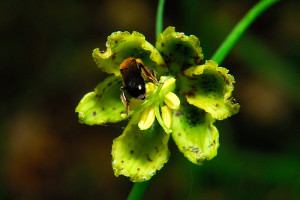
We haven't yet identified this species of bee. The abdomen is nearly black, with copper-orange colored hairs on the thorax
I searched carefully in this area to see if I could find more Fritillarias blooming, but I only found one other, albeit damaged, specimen growing nearby. Apparently deer like to eat the buds from these flowers, so these blooms may not last for long.
The roots of Fritillaria affinis have long been known as an important food resources for many native peoples of the west including the Okanagon, Salish, Shuswap, and Thompson. [3]
This Fritillaria was growing in an area that we’ve invested countless hours over the last few years diligently removing invasive French Broom. There are still occasional broom seedlings that sprout after the rains, but they’re now relatively easy to keep under control.
There’s a certain sense of self-satisfaction that comes from seeing a truly wild native plant re-appear in area that was once completely infested with invasive non-natives. Hopefully we’ll find even more Fritillaria blooming in the same area next year.
———————-
[1] Hickman, James C., editor. 1993. The Jepson Manual Higher Plants of California
[2] Fiedler, P.L. and Watters, C. M. Rare Lilies of California. 1996 California Native Plant Society
[3] Daniel E. Moerman’s Native American Ethnobotanical Database

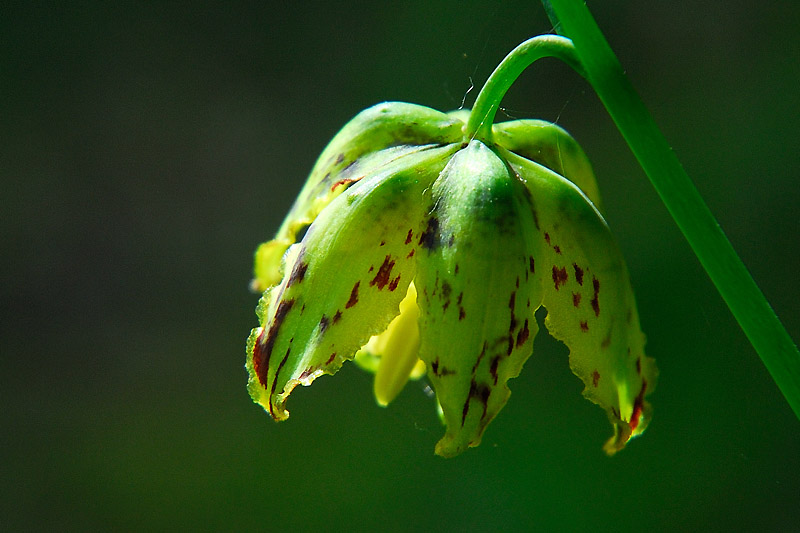
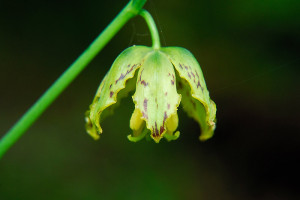

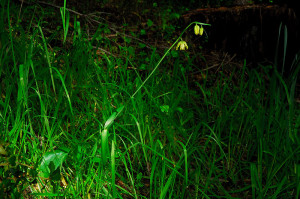
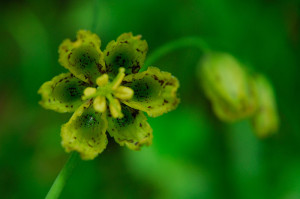
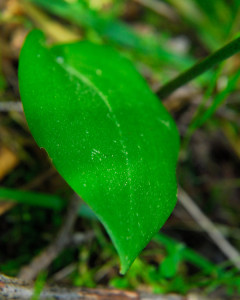
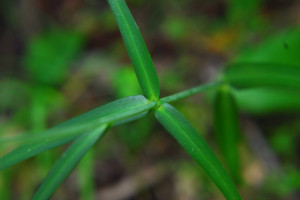
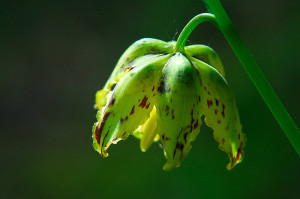
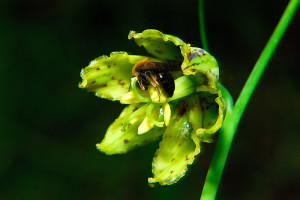
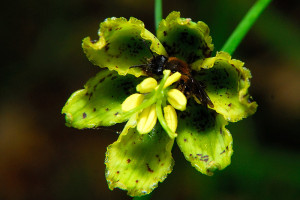
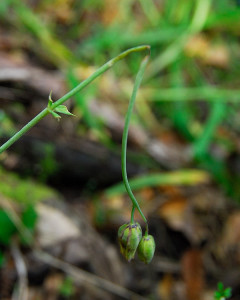
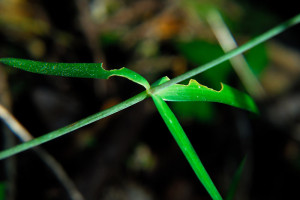
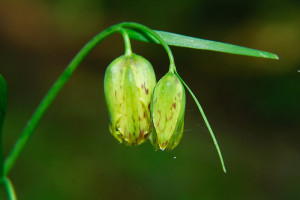







Dear Clare, I would have been right there with you . . . in delightful squeals! Congratulations!! I am sure your clearing out the broom has allowed this jewel to resurface. I love the delicate bloom. What a treasure and i would guess it made your day if not week. Brava!
It definitely made my day…something else just made my week, but that’s for tomorrow’s post 😉
Squeeeeeeeee!!!!!!
I adore fritillaria! You are a lucky woman to have found this on your property.
I’m very lucky. After finding so many wildflowers last spring, and never seeing one, I figured they just didn’t grow here. I’m so happy to be wrong! 😉
How cool is that! I’m so glad for you, and lovely photos!
Very cool!!!
What a beauty. And I agree it must be very gratifying to have such flowers appear naturally. That bee looks like the species of wild mason bees we have in our garden (Osmia rufa or Osmia bicornis). But it’s hard to tell. I am also prone to squealing in the garden!
I thought he looked a little like a red Mason Bee too, but I’m not sure his body shape is quite right. Trouble is, there are soooo many native bees! Might take me a little while before I know for sure who this fellow was.
A rare find and a rare beauty too by looking at your great photos!
Oooh, I am green with envy, what a gorgeous find. I have a weakness for frits, and am on a mission to have as many different varieties as I can find. Love the mottling on the petals.
Clare, you must be beyond excited, as was I reading this post. that flower is absolutely wonderful and the sense of accomplishment knowing that removing the weeds helped clear the way for its growth. Congratulations.
It’s so exciting finding something like this in the wild and I hope that the deer don’t find it too soon. All of the Fritillaria in my garden have been planted by myself and last year I let them go to seed and now I have tiny blades of grass which eventually will become fritillaria blooms once they are big enough.
I think your bloom is very attractive and most unusual compared to the UK Fritillaria. It looks very elegant as it hangs from that stem.
Sorry about the devasating weather you’ve been having. Spring equinox always seems to bring the storms……. we’ve gale force winds here today.
Fantastic,…I can imagine your joy! I know I have a running list of the natives on our place nad if I find a new one, I’m over the moon, but this little beauty! What a find! Nice photos with a nice fine focus: brings out the ruffley edges of the bloom. And the furry feet of the bee.
I’m the same way, I keep tabs on all the natives I find here. I’m surprised that I’m still finding ones I haven’t seen before!
Lucky you. No wonder you squealed. It looks very elegant. Fritillarias are wonderful flowers and you must be very proud to have them come to your garden.
Self-satisfaction? How understated! Delight – to see the wild return ;~) An ‘earth smiles in flowers’ moment.
Diana, I love that…’Earth smiles in flowers’…perfect!
I never knew (or more likely had forgotten) that there are native fritillarias. Now you have profiled one, and Ink and Penstemon has described another beautiful native. I will have to look into these.
I hadn’t realized we had so many native Fritillaria here. There are apparently at least five species that occur here in Santa Cruz county. Fritillaria affinis, F. agrestis, F. biflora, F. falcata, and F. liliacea. Three of them are very rare though, but all are quite beautiful! 🙂
Amazing how such small pleasures bring us such great joy. I’m excited for you!
I loved this post, not only because it was about the fritillaria, but because of how excited you were to find it. I hope you find more or that they multiply next year.
I just read a blog post about spraying eggs on plants and that the deer won’t eat them. Have you tried that? Sounded interesting to me.
We have…it didn’t work. While we were trouble shooting our deer fence breaches last spring we tried. The persistent deer decimated the peach tree anyway 🙁
Wow, a beautiful and rare native flower and a native bee to go with it – what a find! That little bee does seem very happy with the discovery and if you could get close enough with the lens it’s probably grinning like a Cheshire Cat too!
The bee seemed very pleased with herself when she found the nectar in the flower. I saw a native bumble bee on the same bloom this morning when I was showing Mr. Curbstone where the flower was! Clearly we need to propagate more of these plants if the bees like them that much! 😉
Yippee! I grinned too when I saw what you’d discovered. They are always a treasure when found and luckily you appreciate it. Too many don’t look closely at what they have growing under their feet.
I use tape to seal bent or broken stems…and still get the blooms to open. Just needs to be held together.
All spring joys to you…I lecture at the Santa Barbara Botanic Garden next week and I can’t WAIT to see what’s blooming everywhere.
Sharon Lovejoy Writes from Sunflower House and a Little Green Island
Oh lucky you! I bet the Santa Barbara Botanic Garden will be ablaze with blooms! The trouble when I go to places like that is I want to come home with one of everything! Thanks for the tape tip, I’ve never tried that!
Among your many other talents, you have a keen eye … beautiful surprise, Clare.
There’s something special about those native wildflowers that we find growing unassumingly in the spring. I like to walk my property in May, keeping a careful eye out for lady’s slippers and trillium. Your fritillaria is a special find. -Jean
Hey Clare,
Science Friday yesterday on NPR had a segment on bees (it was at the end of the broadcast). In particular, they had someone from the DC Museum of Natural History who is a bee expert and he talked about the INSANE # of bee species in the world & us. They web site has a identification tool that may prove helpful. cheers!
Thanks Chef Tanya, I’ll stop by and check out their ID tool. I’ve tried the one at discoverlife.org…but that only narrowed it down to about 60 species 😉
I’m so excited for you! I have a lot of bulb seeds coming up from locally gathered seed, and in a couple years they’ll be ready to share. Not this one, though. I’d love to get some seeds!